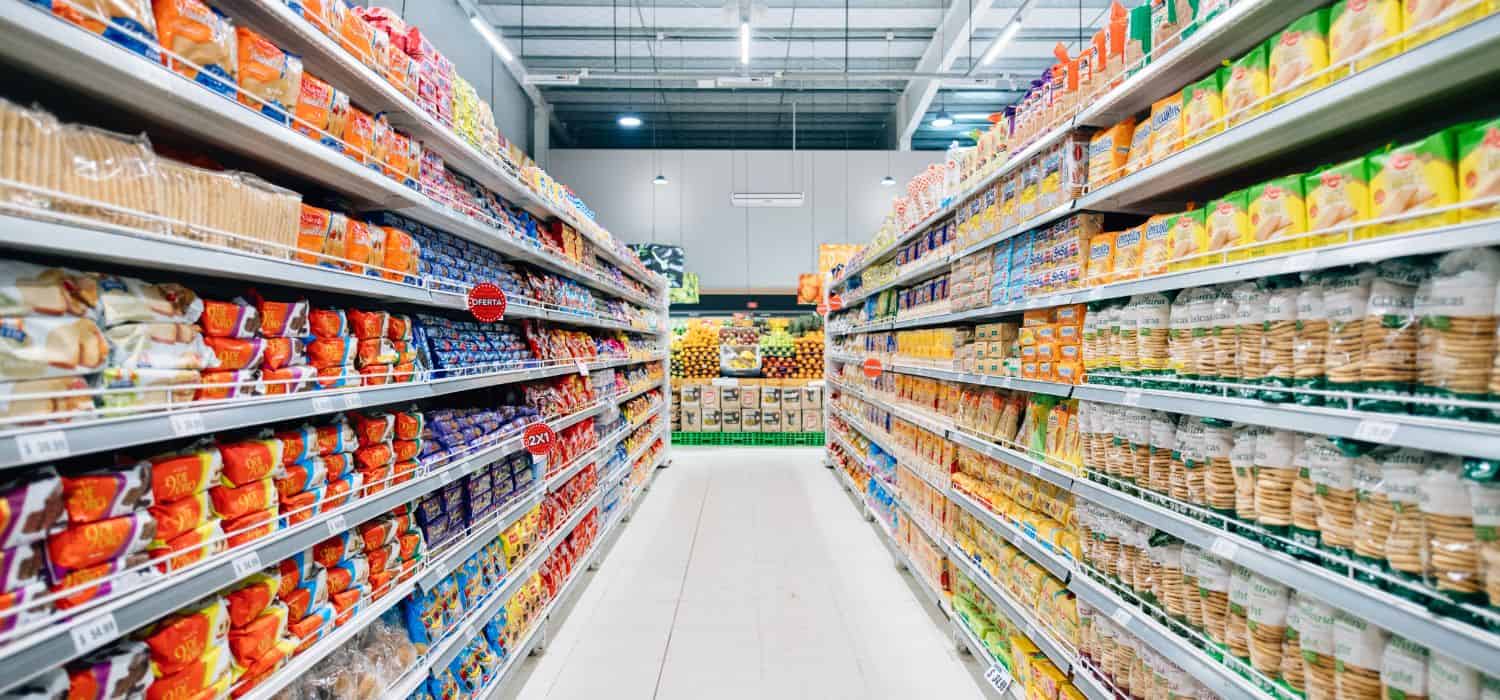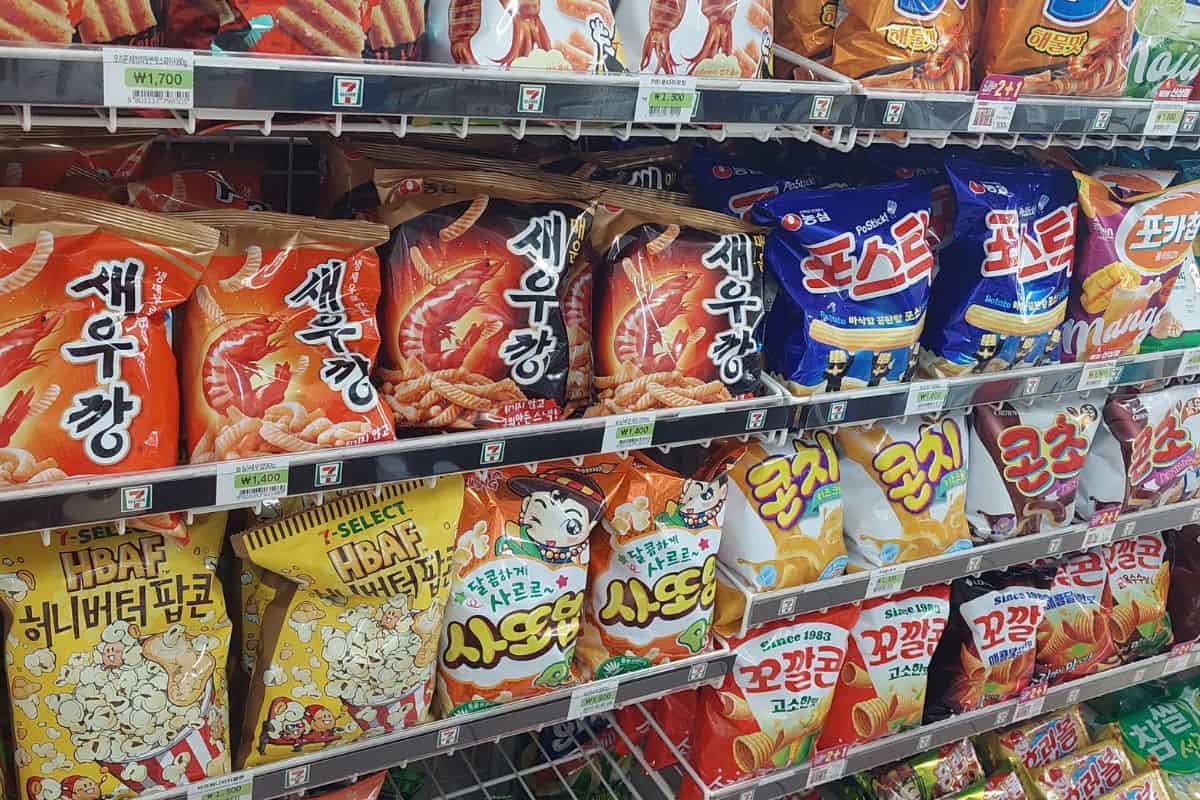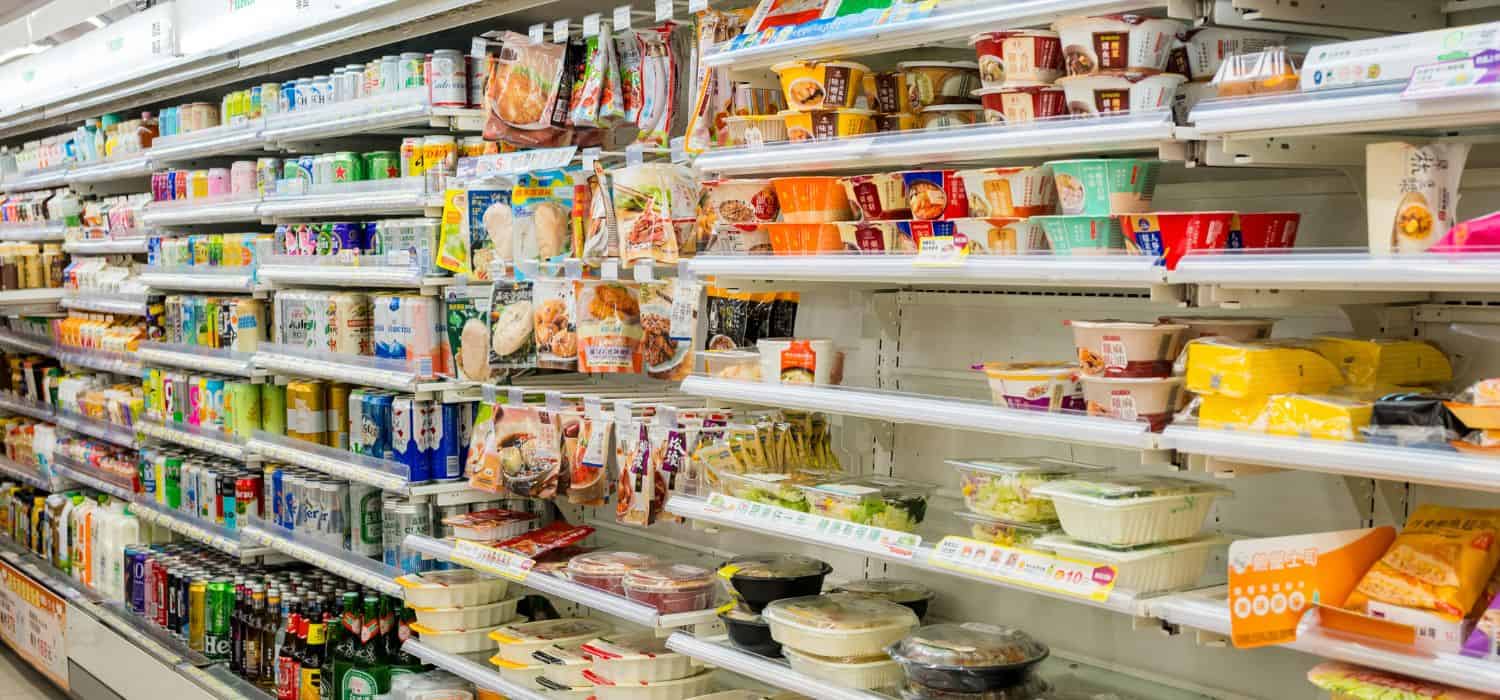When you step into a 7-Eleven store in Japan, you're greeted by an experience unlike any other. The array of products spans from fresh bento boxes and sushi to unexpected items like concert tickets and underwear.
Japanese 7-Eleven stores cater to almost every conceivable need, even allowing you to pay your utility bills in-store.
In contrast, 7-Eleven in Korea offers its own unique charm. Korean 7-Elevens are known for their selection of spicy pickled dishes, like kimchi, plus various hot bar options featuring meat and fish on sticks. You can also enjoy a variety of delicious and affordable Korean snacks and ready-to-eat meals.
These differences highlight how 7-Eleven adapts to local tastes and needs. Whether you're grabbing a quick bite in Tokyo or Seoul, each store offers a unique slice of convenience and culture. Dive in and explore what makes these convenience stores in Japan and Korea so distinct.

Jump to:
🧐 Historical Background and Evolution
Origins of 7-Eleven in Japan and Korea
In Japan, 7-Eleven's journey began in 1974, when Ito-Yokado Co. collaborated with the Southland Corporation of the United States to launch the first store in Tokyo’s Koto Ward. The initial focus was on providing a wide range of goods and convenience to urban residents.
Korea saw its first 7-Eleven store in 1989, introduced by the Lotte Group, which sought to replicate Japan's success. This launch tapped into Korea's growing urbanization and increasing demand for quick and convenient shopping solutions. The early days in both countries laid a foundation for robust retail growth.
Expansion and Growth
Japan quickly embraced the 7-Eleven model, with franchises increasing across the country. By incorporating technology such as point-of-sale systems and efficient distribution networks, 7-Eleven became a retail giant.
The company focused on diverse products, including fresh food and daily necessities, facilitating rapid expansion.
Korea’s expansion mirrored Japan's, albeit at a slower pace. Franchising became a key growth strategy, allowing local entrepreneurs to operate under the 7-Eleven brand.
The brand adapted to local tastes, offering Korean and international products. Both nations saw a rise in store density, particularly in urban areas where convenience shopping became essential.
Economic and Cultural Impact
In Japan, 7-Eleven contributed significantly to the economy. The convenience store model provided job opportunities and supported small-scale suppliers. Its cultural impact was equally profound; thanks to its reliable availability of essentials, it became a staple in Japanese daily life.
Korea experienced similar economic benefits. The growth of 7-Eleven stores boosted the retail sector and provided numerous franchising opportunities.
Culturally, 7-Eleven has adapted to serve the unique needs of Korean consumers, such as stocking items popular among younger demographics and urban professionals, reinforcing its position as a beloved part of daily life.
By comparing Japan and Korea, you can see how 7-Eleven has tailored its approach to meet the specific demands and opportunities presented by each market, ultimately embedding itself deeply into the retail landscape.

🏪 7-Eleven Business Model and Operations
Franchise System
In Japan and Korea, 7-Eleven employs a franchise system allowing individual business owners to operate under the 7-Eleven brand. Franchisees benefit from the brand’s established reputation and comprehensive support provided by the parent company.
This support includes initial training, ongoing education, and marketing strategies to ensure consistent service quality.
Franchise agreements often include detailed guidelines on store layout, product assortment, and branding. This uniformity helps in maintaining customer expectations across locations.
Franchisees also pay royalties and fees, contributing to the company's revenue stream. This system ensures a steady revenue flow while expanding the brand's reach.
Supply Chain and Logistics
A crucial part of 7-Eleven's success is its extraordinary supply chain and logistics operations. The company uses advanced technology for inventory management and restocking, ensuring that stores are always well-stocked with items that customers need. Freight routes are optimized to reduce costs and improve efficiency.
In Japan, 7-Eleven has even pioneered hot food counters and ready-to-eat meals, leveraging limited space for maximum impact. This approach has been highly successful, and similar strategies are being considered for implementation in the U.S. market.
The company’s logistics network also supports its rapid introduction of new products, which keeps customers returning.
In-Store Experience
The in-store experience at 7-Eleven is tailored to local preferences, making it a unique place to shop. In Japan, stores are known for their wide variety of fresh and high-quality food items, including sushi, onigiri, and matcha-flavored desserts.
The focus in Korea might differ, but the aim is the same: offering a range of products that meet local tastes and preferences.
Stores are designed to maximize space and efficiency. Bright lighting, clean aisles, and clearly labeled sections make it easy for customers to find what they need quickly. This optimized shopping experience keeps customers satisfied and encourages repeat visits.

🤓 Comparative Analysis of Product Offerings
Food and Beverages
In Japan, 7-Eleven stores are known for their diverse food options, especially bento boxes, sushi, and hot meals like ramen. You can find freshly made onigiri, karaage (fried chicken), and a variety of sandwiches with unique flavors such as egg salad or pork cutlet.
In contrast, Korean 7-Eleven stores emphasize instant noodles and a variety of rice dishes. Tteokbokki (spicy rice cakes) and kimchi fried rice are popular items. Drinks in Korean stores include an array of flavored milk, rice drinks, and traditional teas.
Both stores sell coffee, but Japanese stores often feature premium canned coffee options, whereas Korean stores offer more localized flavors like honey citron tea.
Snack Foods and Confectionery
Japanese 7-Elevens are famous for their assortment of seasonal and traditional snacks. You will find plenty of mochi, red bean pastries, and green tea-flavored treats. Japanese snacks often include regional specialties, making every visit potentially surprising.
Korean 7-Eleven stores, on the other hand, showcase a variety of spicy chips, seaweed snacks, and sweet rice cakes. Korean snacks also lean towards bold flavors such as cheese, hot pepper, and honey butter. The confectionery section often includes Choco Pies, Pepero sticks, and gum and candy variations.
Fresh Food and Ready Meals
Regarding fresh food, Japanese 7-Eleven stores excel with their meticulously prepared bento boxes. Options often include sushi sets, grilled fish, and mixed vegetable dishes. You can also find fresh salads, fruit cups, and yogurt.
Korean 7-Eleven stores focus on convenient ready meals like bibimbap (mixed rice bowl), gimbap (seaweed rice rolls), and an array of pre-packaged Korean dishes that just need heating. They also offer fresh sandwiches and salads, often with a Korean twist, such as adding bulgogi (marinated beef).
Both countries provide a comprehensive experience tailored to their customers' culinary preferences, but the specific offerings reflect local tastes and customs.
🗺️ Cultural Adaptations
Localization Strategies
In Japan, 7-Eleven has perfected the art of maximizing limited space due to high real estate costs. Stores are designed to be compact yet packed with various products.
You'll notice an array of ready-to-eat meals, including ramen, onigiri (rice balls), and bento boxes. These stores also offer unique services like paying utility bills and sending packages.
In Korea, 7-Eleven has focused on creating a community-centric atmosphere. Many stores feature seating areas where you can enjoy your purchases. There's also a strong emphasis on trendy and seasonal items, often influenced by popular media. Korean 7-Eleven stores frequently introduce new and unique snacks that keep customers returning to see what's new.
Influence of Local Tastes and Preferences
Japanese 7-Elevens cater heavily to local tastes, providing items that resonate with traditional and modern Japanese food culture.
You’ll find many packaged food items, including sushi, soba noodles, and various teas. These stores even offer health-conscious options like salads, reflecting the Japanese emphasis on a balanced diet.
In contrast, Korean 7-Elevens offer a mix of local and international flavors, aiming to appeal to diverse customer preferences. You might see items like tteokbokki (spicy rice cakes), kimchi, and American snacks.
Korean stores also focus on providing quick meal options that cater to their customers' fast-paced lifestyles, ensuring that there’s something for everyone.

📈 Economic and Competitive Landscape
Market Analysis and Trends
In Japan, 7-Eleven has become ubiquitous, with over 20,000 stores, while Korea hosts approximately 10,000 outlets.
These stores go beyond convenience, offering a wide range of products such as ready-to-eat meals, household goods, and financial services. Changes in consumer habits, demanding more convenience and variety, push these stores to innovate continuously.
In Japan, nearly 80,000 foreigners work in the industry, reflecting the country's aging population and the need for a diverse workforce. In Korea, the market is highly competitive, with new players constantly emerging, challenging 7-Eleven to maintain its market presence.
Comparison with Competitors
Competitors such as FamilyMart, Lawson, and Ministop present formidable challenges to 7-Eleven in both countries. In Japan, FamilyMart and Lawson command strong brand loyalty and strategic store placements.
Each aims to differentiate itself through unique offerings, such as FamilyMart's Famichiki (fried chicken) and Lawson's premium dessert range.
Korea's market sees fierce competition from GS25 and CU stores, which have a significant presence. FamilyMart and Ministop also compete, with Ministop offering more in-store dining options.
This competition forces 7-Eleven to innovate continually, adapting to the preferences and demands of local customers.
Future Outlook and Challenges
The future of 7-Eleven in Japan and Korea depends on its ability to adapt to emerging trends such as digital payment solutions and eco-friendly initiatives.
In Japan, addressing the labor shortage with technologies like AI and robotics is crucial. Enhancing the in-store experience with more self-service options and automated systems may provide a competitive edge.
Korea's 7-Eleven stores must navigate challenges like strict regulations and high urban real estate costs. Embracing omnichannel strategies that integrate online and offline services could help mitigate these challenges.
Adapting to consumer preferences for healthier, locally sourced products will also be critical to maintaining market leadership.
❓ Frequently Asked Questions
In Japan, you'll find freshly made bento boxes, onigiri rice balls, and premium coffee drinks. In Korea, don't miss out on hot bar snack items like meat and fish on sticks, as well as spicy pickled cabbage, also known as kimchi.
Prices in both countries can vary depending on the item. Japanese 7-Elevens often feature premium items that can be a bit pricier. Korean 7-Eleven stores offer affordable street food snacks, which might be a more budget-friendly option.
Exclusive items differ between the two countries. Japanese stores often stock uniquely flavored snacks and beverages, while Korean stores offer exclusive local favorites such as various kinds of kimchi and street food-inspired snacks.
In Japan, you can pay utility bills, book concert tickets, and use mobile phones or IC transit cards at 7-Eleven stores. These convenient services are not typically found in Korean 7-Elevens.
Traditionally, 7-Eleven stores in Japan are open 24 hours, ensuring round-the-clock convenience. Korean 7-Elevens may not have uniform operating hours, and some might not be open 24/7, differing by location.
Japanese 7-Elevens highlight the country's culinary staples like rice balls and bento boxes. In Korea, you'll see the influence of local cuisine with items like spicy kimchi, bento boxes featuring local ingredients, and street food snacks reflecting Korean taste preferences.





Comments
No Comments